
Meet us at Bengaluru Tech Summit in Hall No. - 1, Booth no. - C58
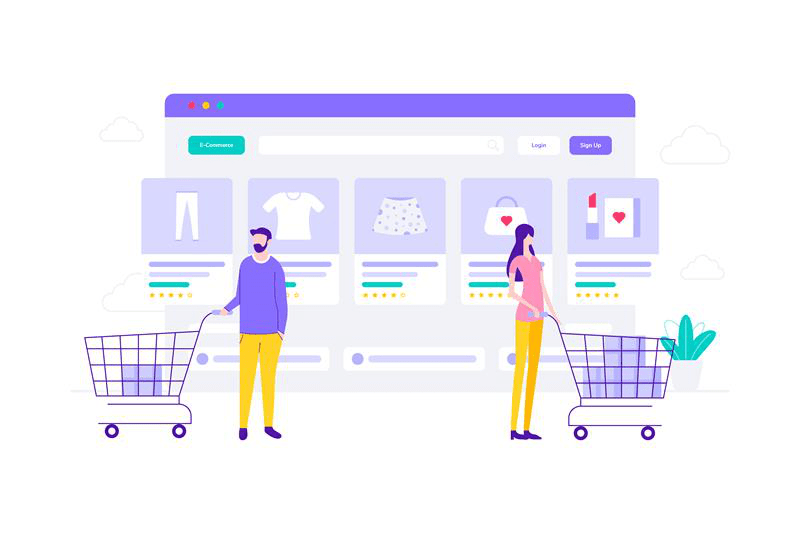
The online commerce boom isn’t coming because it’s already here.
Let’s call it out, eCommerce has become the business battleground of the present and future. Whether you’re a seasoned business leader or a startup founder on the rise, this moment is knocking on your digital door with an opportunity that’s too big to ignore.
And, this guide isn’t your typical rundown of tech jargon and dry definitions. It’s a straight-talking, insight-packed article that breaks down eCommerce software development, what it means, what it powers, and why getting it right could unlock exponential growth for your business.
So, why should you care (and click)?
Remember when shopping online was new? Amazon was mostly books, and eBay was like a digital garage sale. Fast forward to now, and online shopping is huge, worth over $3 trillion. Yes, with a T.
It's getting bigger. The online shopping world is predicted to hit $83.26 trillion by 2030, growing fast. This shows the game has changed, and those who act fast will win.
People want things fast, easy, and personal. So, businesses can't treat selling online as just an extra. It's not just about having another store online. It's about making a strong online business that can keep up and make lots of money.
But today's online shopping is more than just shopping carts. It's about creating programs that can handle everything, like safe payments, knowing what's in stock right away, sending things in different ways, giving good suggestions, and making things easy, whether you're on a phone or computer, no matter where you are.
Because they are more interested in creating the track, astute businesspeople are not merely entering the digital race. Custom-built eCommerce applications are becoming the foundation of flexible, revenue-driven business models as a result of the growth of virtual marketplaces and modern customer expectations.
Do you want to prepare your company for the future? Software that changes as quickly as your users does is what you need.
As an integrated suite that handles orders, payments, user behaviour, analytics, security, and customer engagement, all while being scalable and simple to maintain, you need a platform that does more than just "support" sales; it must actively drive them.
This is a significant change in the way that the world grows, buys, and sells. The ROI has never been higher, and the entry barriers have never been lower. Therefore, the true question is: Are you creating your own advantage, or are you observing others create theirs?
This guide will take you through the basics, without any extraneous details, whether you're starting your first online store or want to improve your current commerce setup.
It's time to stop reading headlines and start creating your own if you want to capitalise on the upcoming wave of success in online retail app development. Let's look into the eCommerce engine.
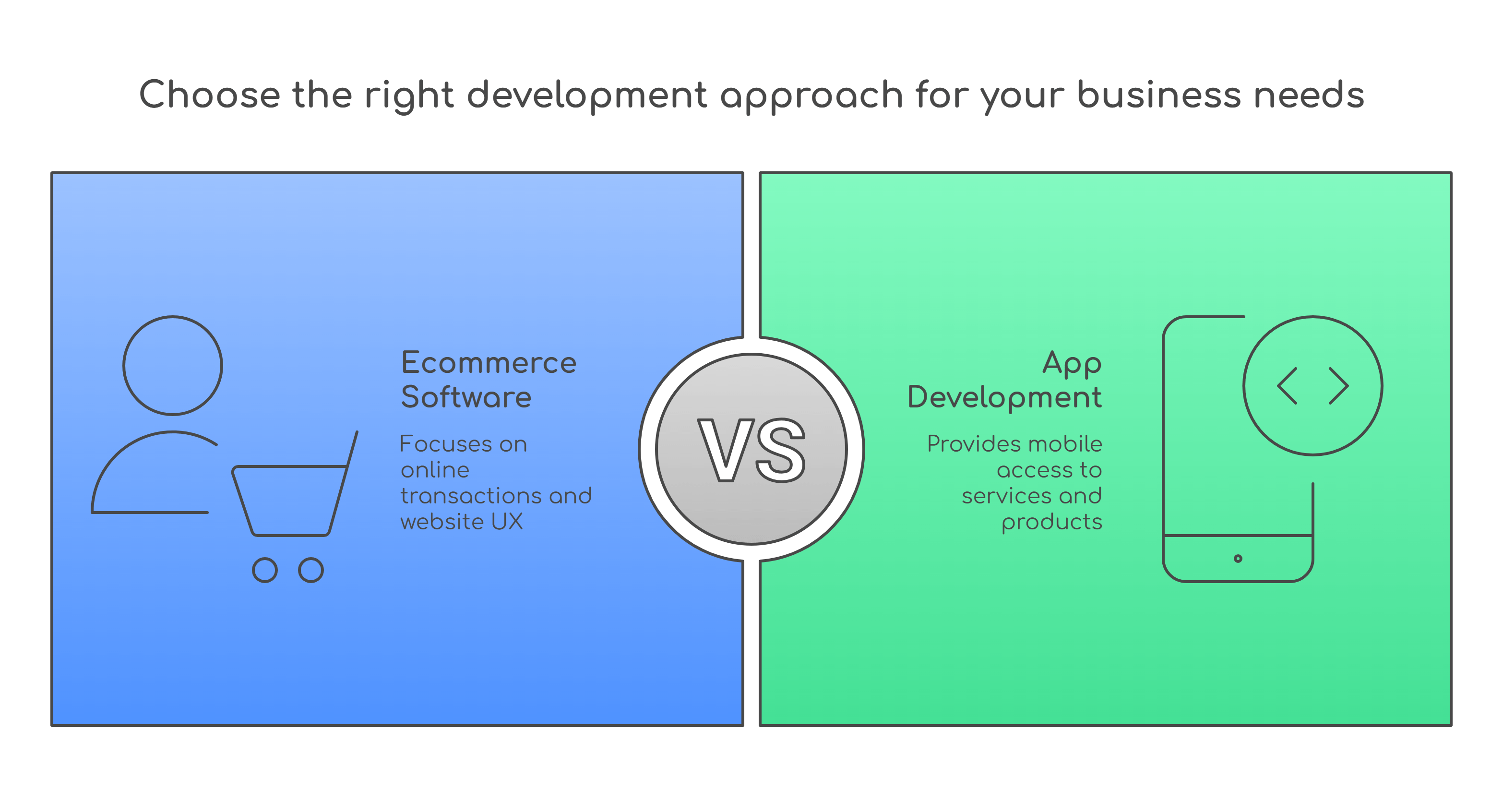
When businesses consider going digital, they usually ask, Should we build an online store or a mobile app?
Both let you sell online, but they fix different problems and give different experiences. They're also made for different ways people act. Knowing the small differences can help you make better choices for your business.
Let's look at it closely.
It's like the main computer for all your online selling. It's usually a website that lets you:
Think of Shopify, Magento, Squarespace, or a website you build to control and grow your online business.
Good for: Businesses who want a solid, expandable online shop for customers on computers, tablets, or phones.
It's about making things work well on phones first. These are apps that people download and use on their phones. These apps are made to:
Good for: Brands focused on people who mostly use phones—such as a dropshipping business—and want to keep them interested and loyal with special app experiences.
It's not always one thing or the other. Actually, today's best online stores use a good website to get noticed and make sales, plus an app to keep customers coming back with special offers.
If you're just beginning, a website is usually the quickest way to get going. But if you're growing fast and want to get closer to your customers, you should think about making a mobile app soon.
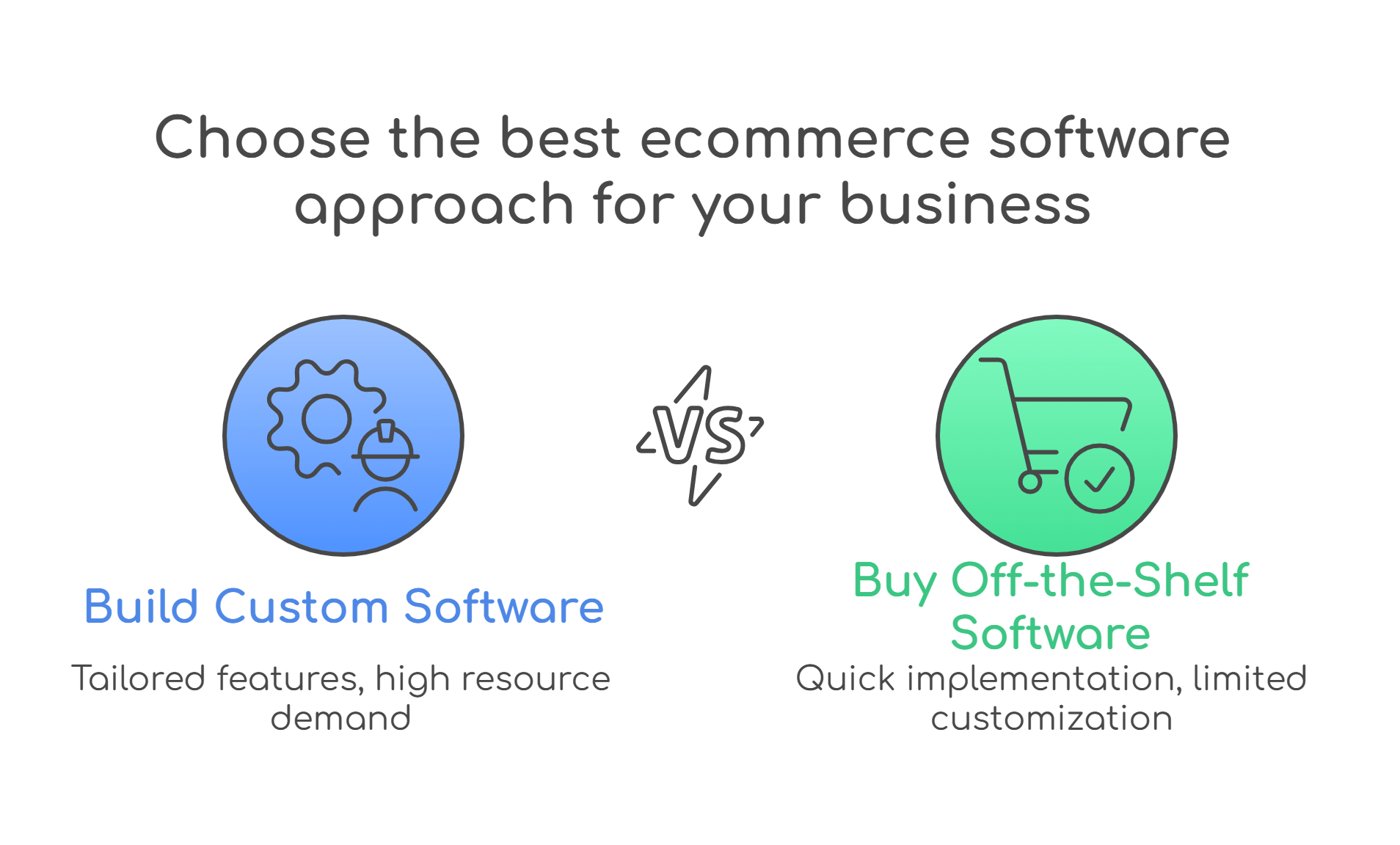
As a business grows, it faces a big question: Should we build custom software with the help of an experienced ecommerce app development company or just buy something ready-made?
This choice is about more than tech. It affects your time, money, how well you can grow, and how prepared you'll be for what’s ahead.
Well, things are moving fast these days and customers expect a lot. Businesses can’t just throw money at tech without thinking. Buy vs Build is really about being smart with what you have by focusing on a custom solution or getting things done quickly with something already available.
This isn’t about following trends; it’s about picking what’s best for you.
To make a good choice, look at the long-term pros and cons, not just the price at the start.
If you build software, you get total control. You can shape it to fit how you work, what your users want, and your plans for the future. Still, it takes more time. You’ll need more cash, good developers, and time you might not have right now.
If you buy software, though, you can get going right away. It’s quicker, cheaper at first, and ready to use. Still, you lose some flexibility. You'll probably need to adjust to what the tool can and can't do, or pay extra for every small change.
A good buy versus build look should step back to consider:
Think about what you can actually do in-house. Do you have the team to build it? Or is buying better while you work on your main business? The aim is to be clear on what you're doing, so you don't just react to what you find, but make a choice that helps you grow.
Ultimately, there’s no single right answer. What helps one company might hurt another. The trick is to check both options against what you want, what you can do, and where you’re headed, not just what you need today. If you think about it, this can give you an edge over others, boost new ideas, and make sure you’re building something that’s worth what it costs.
Businesses don't just decide out of the blue to create their own software. It usually happens after they've grown too big for the simple, ready-made solutions out there.
That's when they start wondering: Should we stop paying for a solution and start building our own?
So, when should you think about getting custom e-commerce software? Not just to seem cool or because your rivals are doing it. But when your current systems begin to limit your growth instead of helping it. Here's what to look for.
If you're experiencing any of these red flags, custom e-commerce software is something you need.
If your team is struggling to get around what your current tool can't do, that's a red flag. Software should fit how you work, not the other way around.
Most standard platforms have basic stuff. But if you want to make special customer experiences, different pricing levels, tricky B2B setups, or rules that change by location, it's like trying to force a square peg into a round hole.
If your current setup feels like a patchwork of apps, it's time to bring things together with a special solution that understands your needs and your tech.
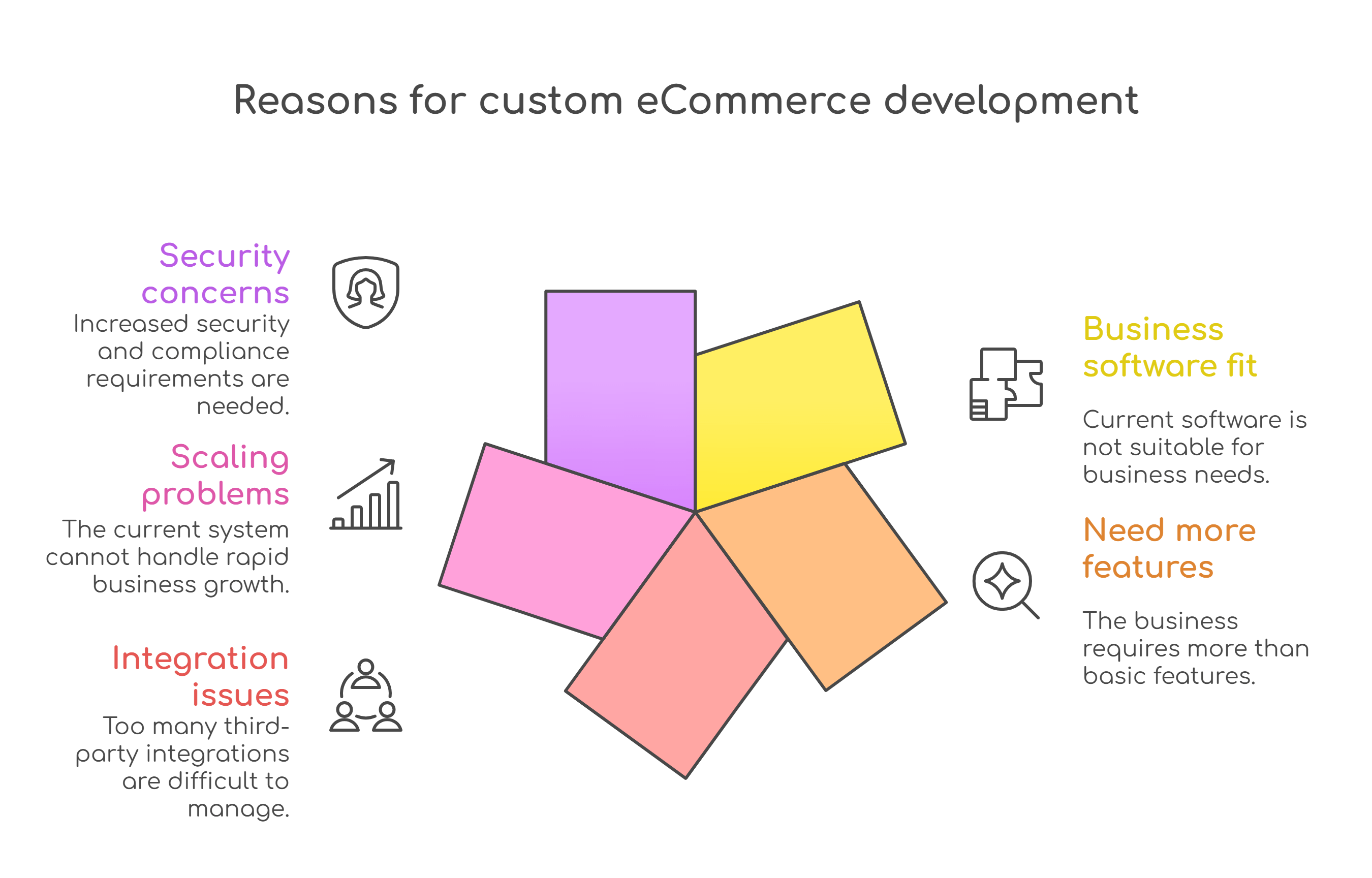
When you grow, you see what your tools can really do. If your store starts slowing down, breaking, or getting jammed up by traffic or data, then special development gives you a base that's made to grow, not stop.
Standard solutions have shared risks. With special eCommerce, you control how data is used, how deals are safe, and how privacy is part of the plan from the start.
Custom eCommerce isn't just about adding more stuff. It's about making things line up better.
So, custom eCommerce software is an investment, not a quick fix. It takes time, clear thinking, teamwork, and knowing where you're headed. If you're still figuring out if people want your product, or if your business changes all the time, then a standard option might be better. But if you know your business works and you're ready to own your tech instead of just renting it, now's the time.
Let’s get one thing straight: There’s no universal price tag for eCommerce software. Anyone who tells you otherwise is probably selling an admin template.
Building eCommerce software is like building a house. You can choose a prefab flat, a mid-sized family home, or a custom-built mansion with ocean views. The cost? It scales with your ambition, complexity, and the craftsmanship involved.
So instead of hunting for “the number,” here’s how to think about the cost the right way.
Before you jump to numbers, it’s important to understand the variables that shape your final bill.
Are you building a basic online store or a multi-vendor marketplace like Amazon?
Will it just manage products and payments, or are you adding real-time inventory, AI-based recommendations, loyalty programs, multi-language support, etc.?
Do you need a plug-and-play UI, or are you going for a pixel-perfect branded experience?
Is your platform expected to handle hundreds of users or millions?
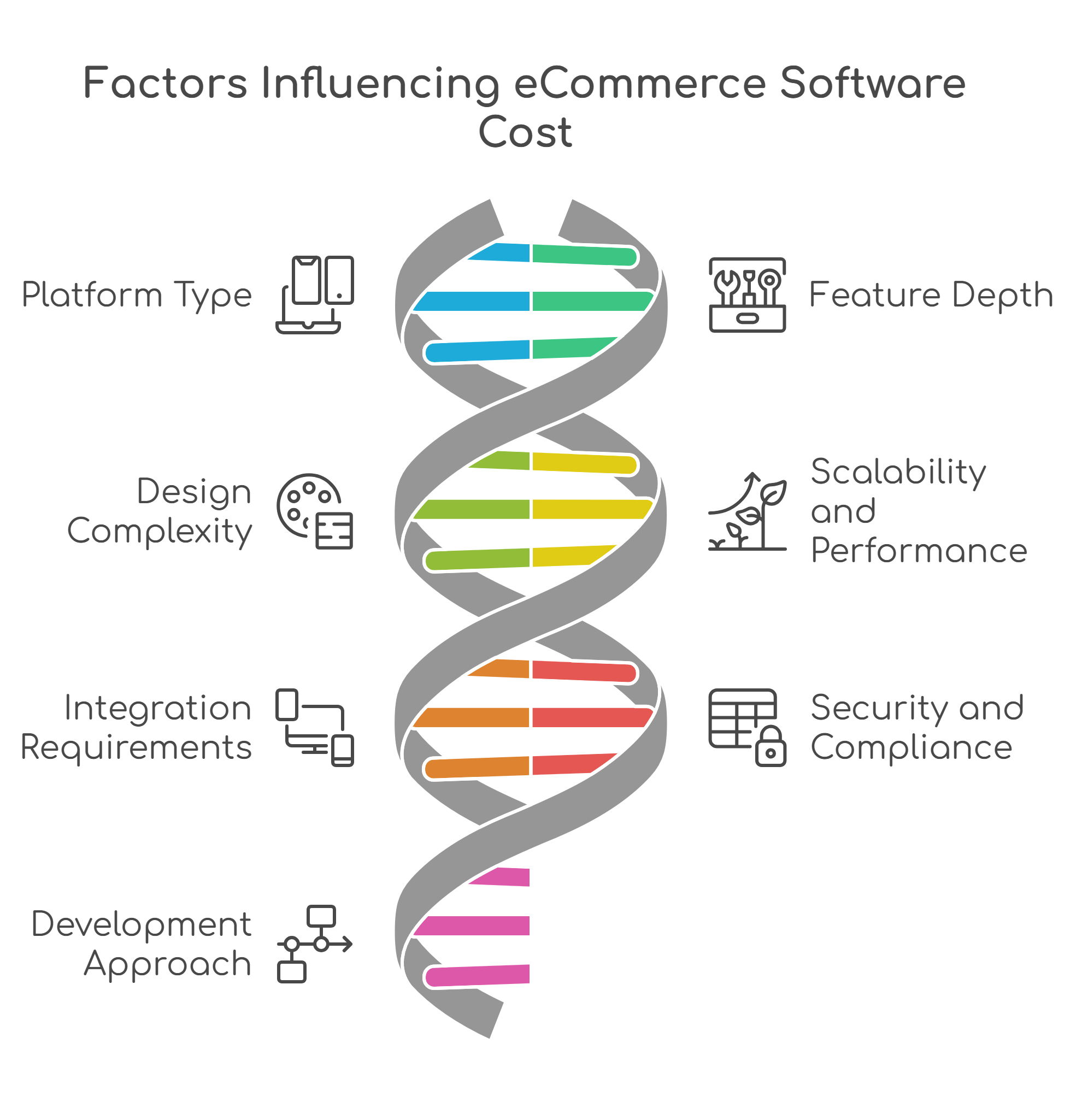
ERP, CRM, shipping, payments, analytics—third-party integrations can add up fast.
If you’re in regulated industries (e.g., pharma, fintech, healthcare), custom compliance layers will affect the cost.
Are you hiring freelancers, working with an app development company, conisdering ecommerce app builder or building an in-house team?
Note: These are ballpark figures. Costs vary based on region, tech stack, and team composition.
Let’s not sugarcoat it, development isn’t the only bill you’ll get. Consider:
Skipping these from your budget plan is a rookie mistake.
Okay, so the ideal budget? It's what lets you grow, shows off your brand, and gives customers a great experience. Forget asking How much will this cost? Instead, think, What do we want to achieve, and how much is that success worth? When you find the right thing, e-commerce software isn't just something you get; it's what drives your future success.
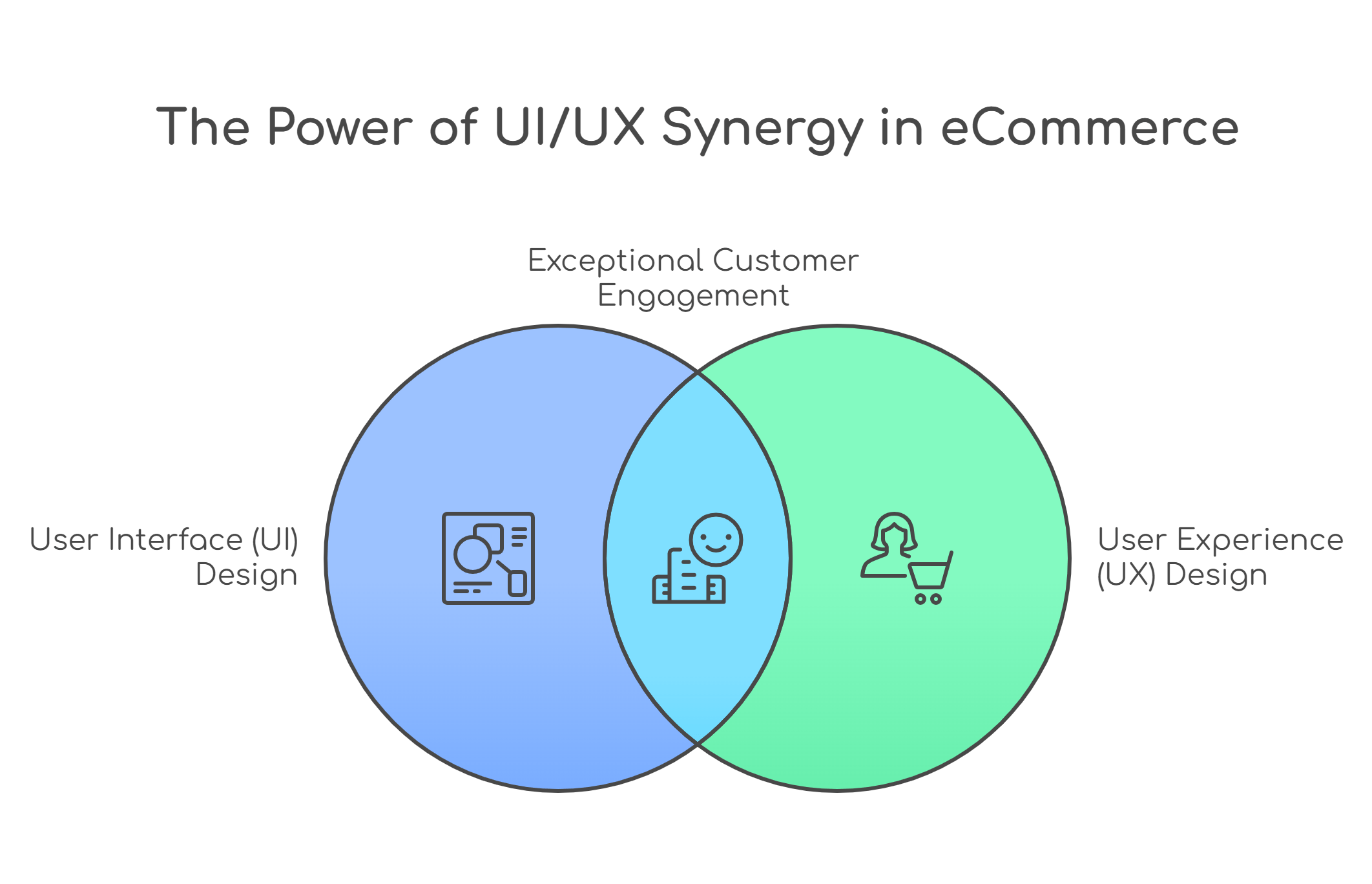
You can build the fastest backend. You can integrate the smartest tools. You can even have killer product pricing. But if your UI/UX lacks? You’ll lose the customer before the second click.
But, let’s not sugarcoat it, your user interface (UI) and user experience (UX) are your brand. They are the first handshake, the welcome mat, the showroom, and the checkout lane, all rolled into one.
And in a world where your competitor is just a tab away, you don’t get a second chance. That’s why investing in strong UI/UX is a growth lever. A conversion multiplier. And often, the only thing standing between bounce and buy.
Too often, teams think UI/UX is just about making things “look pretty.” But here’s what it really means when it comes to eCommerce:
What poor UI/UX costs you?
Bad UI/UX doesn’t just annoy users. It:
The worst part? Most businesses don’t even realize poor UI/UX is the reason they’re bleeding revenue, until it’s too late.
Good UI/UX is what links how something works with how it feels to use it. Want to create an eCommerce site folks enjoy? You gotta bake UI/UX into everything – the plan, design, coding, and even the content. Online, how it feels is what you're selling. And if using your site is a pain, promotion won't fix it.
At Antino, we don’t just build eCommerce platforms, we create experiences that get you real sales. Starting from scratch or growing what you have, our team gets to know your processes, problems, and what you want to achieve. Then we build custom eCommerce solutions that match your goals for growth. From easy-to-use designs to strong behind-the-scenes tech and smooth connections to your favorite tools, we make sure your platform does what your business and customers need.
We're experts across many industries and technologies, so we bring speed, growth potential, and flexibility, all while keeping quality high. Whether you're starting a small marketplace or a big brand that sells directly to consumers, we help you control your online space and make it an advantage. Ready to move past those generic platforms? Let’s build your eCommerce software in your style.
